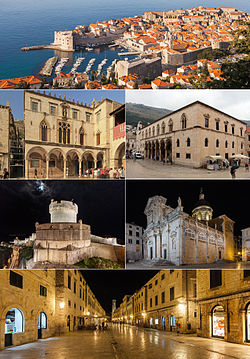
Back Dubrovnik Afrikaans Ragusa AN دوبروفنيك Arabic دوبروفنيك ARZ Dubrovnik AST Dubrovnik Azerbaijani Дуброўнік Byelorussian Дуброўнік BE-X-OLD Дубровник Bulgarian Dubrovnik Breton
Dubrovnik
Ragusa | |
|---|---|
| Grad Dubrovnik City of Dubrovnik | |
 Clockwise from top: Dubrovnik Old Town, Rector's Palace, Dubrovnik Cathedral, Stradun, Walls of Dubrovnik, Sponza Palace | |
| Nicknames: "Pearl of the Adriatic", "Thesaurum mundi"[citation needed] | |
 | |
| Coordinates: 42°38′25″N 18°06′30″E / 42.64028°N 18.10833°E | |
| Country | Croatia |
| County | Dubrovnik-Neretva |
| Government | |
| • Type | Mayor-Council |
| • Mayor | Mato Franković (HDZ) |
| • City Council | 21 members |
| Area | |
| • City | 142.6 km2 (55.1 sq mi) |
| • Urban | 12.1 km2 (4.7 sq mi) |
| Elevation | 3 m (10 ft) |
| Population (2021)[2] | |
| • City | 41,562 |
| • Density | 290/km2 (750/sq mi) |
| • Urban | 26,922 |
| • Urban density | 2,200/km2 (5,800/sq mi) |
| Time zone | UTC+1 (CET) |
| • Summer (DST) | UTC+2 (CEST) |
| Postal code | HR-20 000 |
| Area code | +385 20 |
| Vehicle registration | DU |
| Patron saint | Saint Blaise |
| Website | dubrovnik |
| Official name | Old City of Dubrovnik |
| Criteria | Cultural: (i)(iii)(iv) |
| Reference | 95 |
| Inscription | 1979 (3rd Session) |
| Area | 96.7 ha (239 acres) |
Dubrovnik (UK: /d(j)ʊˈbrɒvnɪk/ dyuu-BROV-nik, US: /duːˈ-/ doo-,[3] Croatian: [dǔbroːʋniːk] ⓘ),[4] historically known as Ragusa (Italian: [raˈɡuːza] ⓘ; see notes on naming), is a city in southern Dalmatia, Croatia, by the Adriatic Sea. It is one of the most prominent tourist destinations in the Mediterranean, a seaport and the centre of the Dubrovnik-Neretva County. Its total population is 41,562 (2021 census).[5] In 1979, the city of Dubrovnik was added to the UNESCO list of World Heritage Sites in recognition of its outstanding medieval architecture and fortified old town.[6]
The history of the city probably dates back to the 7th century, when the town known as Ragusa was founded by refugees from Epidaurum (Ragusa Vecchia). It was under the protection of the Byzantine Empire and later under the sovereignty of the Republic of Venice. Between the 14th and 19th centuries, Dubrovnik ruled itself as a free state. The prosperity of the city was historically based on maritime trade; as the capital of the maritime Republic of Ragusa, it achieved a high level of development, particularly during the 15th and 16th centuries, as it became notable for its wealth and skilled diplomacy. At the same time, Dubrovnik became a cradle of Croatian literature. In his letter to Nikola Nalješković (1564), poet Ivan Vidalić named it "crown of Croatian cities".[7]
The entire city was almost destroyed in a devastating earthquake in 1667. During the Napoleonic Wars, Dubrovnik was occupied by the French Empire forces, and then the Republic of Ragusa was abolished and incorporated into the Napoleonic Kingdom of Italy and later into the Illyrian Provinces. In the early 19th to early 20th century, Dubrovnik was part of the Kingdom of Dalmatia within the Austrian Empire. Dubrovnik became part of the Kingdom of Yugoslavia immediately upon its creation, and it was incorporated into its Zeta Banovina in 1929, before becoming part of the Banovina of Croatia upon its creation in 1939. During World War II, it was part of the Axis puppet state Independent State of Croatia, before being reincorporated into SR Croatia in SFR Yugoslavia.
In 1991, during the Croatian War of Independence, Dubrovnik was besieged by the Yugoslav People's Army for seven months and suffered significant damage from shelling. After undergoing repair and restoration works in the 1990s and early 2000s, it re-emerged as one of the Mediterranean's top tourist destinations, as well as a popular filming location. According to Statista, Dubrovnik is the most 'over-touristed' destination in Europe, with 36 tourists for each resident.[8]
- ^ Register of spatial units of the State Geodetic Administration of the Republic of Croatia. Wikidata Q119585703.
- ^ "Population by Age and Sex, by Settlements, 2021 Census". Census of Population, Households and Dwellings in 2021. Zagreb: Croatian Bureau of Statistics. 2022.
- ^ Jones, Daniel (2011). Roach, Peter; Setter, Jane; Esling, John (eds.). "Dubrovnik". Cambridge English Pronouncing Dictionary (18th ed.). Cambridge University Press. p. 151. ISBN 978-0-521-15255-6.
- ^ "Dùbrōvnīk". Hrvatski jezični portal (in Croatian). Retrieved 6 March 2017.
- ^ "Cultural diversity: Census Information on country of birth, year of arrival, ancestry, language and religion". Australian Bureau of Statistics. 9 October 2022.
- ^ "Old City of Dubrovnik". UNESCO World Heritage Centre. United Nations Educational, Scientific, and Cultural Organization. Retrieved 22 May 2021.
- ^ Baždar-Paušek, Snježana (2020). Dubrovački prirodoslovci u vrhu povijesti znanosti (od 15. do 19. stoljeća) (in Croatian). Dubrovnik: Ogranak Matice hrvatske u Dubrovniku. p. 9. ISBN 978-953-7784-67-6.
- ^ Fleck, Anna (1 June 2023). "The Most 'Over-Touristed' Cities in Europe". Statista.
© MMXXIII Rich X Search. We shall prevail. All rights reserved. Rich X Search



